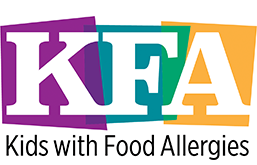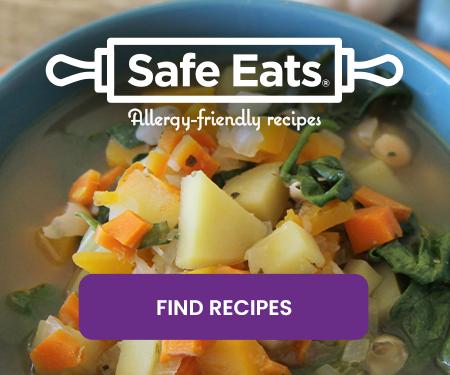Living with Food Allergies

Food Allergen Labeling
The Food Allergen Labeling and Consumer Protection Act (FALCPA) became law in 2004. This law ensures that there would be clearer labeling of food for the millions of people with food allergies. FALCPA went into effect on January 01, 2006.
FALCPA updates the labeling requirements for all food products regulated by the FDA. FALCPA requires that foods are labeled to identify the eight major food allergens. The eight major allergens are: milk, egg, fish, crustacean shell fish, tree nuts, wheat, peanuts and soybeans. These 8 major food allergens identified by FALCPA account for over 90 percent of all documented food allergies in the U.S.
The law also requires that the following be on the food label:
- The specific type of nut (e.g. almond, pecans, walnut, coconut).
- The specific type of fish (e.g. bass, flounder, Pollack).
- The specific type of crustacean shellfish (e.g. lobster, shrimp, crab).
Molluscan shellfish do not have to be labeled in this manner. Mollusks include oysters, clams, mussels, or scallops. They are not considered a major food allergen.
For a look at the complete law, click here.
1. How must labels declare food allergens?
Labels on foods regulated by the FDA must list ingredients which contain one or more of the major food allergens in one of two ways:
- The common or usual name of the major food allergen must be followed by the food source in parentheses in the list of the ingredients. This will occur the first time the major food allergen is listed and does not have to be repeated each time the name of the specific food allergen appears.
Examples: “lecithin (soy),” “flour (wheat),” and “whey (milk)”
- There may be a section after or near the ingredient list called “Contains”. After the word “Contains”, there must be listed the name of the food source from which the major food allergen is derived.
Example: “Contains Wheat, Milk, and Soy.”
A “contains” statement is not required on a food label. Also, the common English name may only be listed in the contains statement and not in the list of ingredients. Therefore, you must read the list of ingredients and any “Contains statement” carefully.
2. What types of foods does the FDA regulate?
The FDA has control over:
- Packaged foods
- Conventional foods
- Vitamins and dietary supplements
- Infant formula and infant foods
- Medical foods
Medical foods include those items produced for people with particular diseases such a phenylketonuria. Medical foods also include items for people that need a particular feeding method, such as tube feedings.
The FDA regulates items produced in the United States. The FDA also regulates items produced outside the U.S. (imported) but intended for sale in the U.S.
FALCPA labeling also applies to all retail and food-service establishments. This includes any foods for sale in vending machines and all packages labeled “for individual sale.”
It is possible that locally made foods may not be in full compliance with FALCPA labeling. Read all labels carefully and contact the manufacturer if you have any questions.
3. Are there any food exemptions to the law?
Yes, FALCPA does not cover fresh fruits and vegetables in their natural state. FALCPA also does not cover any highly refined oil derived for a food specified in the major eight allergen group. FALCPA does not cover any ingredient derived from such highly refined oil. There are clinical studies showing that highly refined oils can be safely eaten by individuals with food allergies. Those highly refined oils contain extremely small levels of allergenic protein.1
4. Are there any other areas not covered by FALCPA?
Yes, there are quite a few areas where the law does not apply:
- Prescription drugs
- Over-the-counter drugs
- Personal care items such as cosmetics, shampoo, mouthwash, toothpaste or shaving cream.
- Any food product regulated by the USDA, which includes meat, poultry, or certain egg products.
- Any product regulated by the Alcohol, Tobacco Tax and Trade Bureau (ATTB). This includes alcoholic drinks, spirits, beer and tobacco products.
- Any restaurant foods or foods that are placed in a wrapper or container in response to a person’s order for that food. This includes street vendors, festival foods, fast food restaurants.
- Kosher labeling
- Pet foods, supplements, and supplies
5. Are flavors, colors, and food additives subject to the allergen labeling requirements?
Yes, any flavoring, spice, coloring, or processing aid that is or bears one of the eight major food allergens must list the allergen in plain English. Processing aids are those items which help in the making of the food product but may not present a major ingredient. They are used, for example, to keep food from sticking to the baking pans or as a carrier for a certain flavor, spice or vitamin. Such a product might be soy lecithin or wheat starch.
6. A new ingredient containing one of the major eight allergens appears on a revised label of a food I have been using. Can I just assume that it was there all along and the food is safe to eat?
No. It may indeed be a new ingredient in a reformulated product. You will need to check with the food company to verify whether the product is safe for you.
7. Are advisory statements, such as “May contain…” required?
No, FALCPA does not require such advisory statements. FALCPA does not require any statement regarding possible cross contact of the food item.
8. Does FALCPA change how the term “non-dairy” is used?
FALCPA does not limit the use of the term “non-dairy” or “dairy free.” The term “non-dairy” continues to appear on foods that contain caseinates (milk-derivatives) as ingredients. The caseinates must be listed in the ingredient section followed by a parenthesis and “milk”. The FDA does not specifically address the term “dairy-free”, so that is not affected by FALCPA at all.
9. How does FALCPA affect gluten and “gluten-free” labeling in food?
On August 2, 2013, FDA issued a final rule defining “gluten-free” for food labeling. This final rule requires that items labeled “gluten-free” meet a defined standard for gluten content. 2
10. Is there a way that food manufacturers can ask to have a food product exempted from FALCPA labeling?
Yes, anyone can petition the Secretary of Health and Human Services to request an exemption to the labeling requirement. The petitioner must submit scientific evidence that such a food ingredient (with a particular production method) does not cause an allergic response that poses a risk to human health. An inventory of notifications received for exemptions from FALCPA can be found here. The site is updated periodically.
References
1. Crevel, RWR, Lerkhoff, MAT; Koning, MMG, “Allergenicity of refined vegetable oils”, Food Chem Toxicol 2000; 38:385-393
2. US Food and Drug Administration. 2013. Gluten and Food Labeling: FDA’s Regulation of “Gluten-Free” Claims Retrieved on December 16, 2022 from federalregister.gov/documents/2013/08/05/2013-18813/food-labeling-gluten-free-labeling-of-foods
What is a Food Allergy?
A food allergy occurs when the body’s immune system sees a certain food as harmful and reacts by causing symptoms. This is an allergic reaction.










